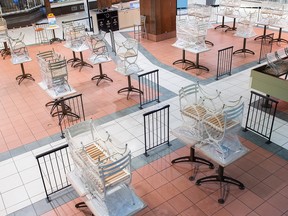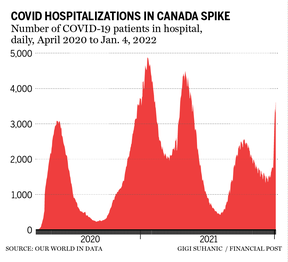[ad_1]
Omicron’s rapid spread is bringing new restrictions and concerns daily. Get the latest news here

Article content
The rapid spread of the COVID-19 variant Omicron across Canada brings more restrictions, curtailments of services and concerns about shortages daily.
Advertisement
This advertisement has not loaded yet, but your article continues below.
Article content
Watch here for the latest news that affects us all in the Omicron outbreak.
4:53 p.m.
North American markets closed in the red on Wednesday as investors ignored rising Omicron cases and instead looked to the U.S. Federal Reserve, which signalled it would raise interest rates sooner than expected.
The S&P/TSX composite index closed down 196.86 points to 21,039.66.
In New York, the Dow Jones industrial average was down 392.54 points at 36,407.11. The S&P 500 index was down 92.96 points at 4,700.58, while the Nasdaq composite lost 522.55 points or 3.3 per cent at 15,100.17.
4:33 p.m.
Albert Truong — one of the thousands of Ontario restaurateurs who lurched back to takeout-only on Wednesday — has been feeling a little relieved this week. Two of the staff at his 120-seat diner Johnny Quests in Thamesville, Ont., are home sick, another two are home isolating, and he wasn’t sure he’d enough people to run a proper indoor service anyway.
“It’s just exhausting,” he said.
But the new public health restrictions bring about more problems. It’s become almost routine at this point. The things that won’t sell on takeout — the juices, the chocolate milk — go to a shelter. And there’s the balancing act with staffing, where the restaurant can’t really afford to pay everyone but can’t afford to lose them all either.
Thamesville, just over an hour east of Windsor, isn’t really a takeout town. There’s no Uber Eats. A lot of the rural customers drive so far enough that the food’s cold by the time they get home. The restaurant’s revenues drop roughly 80 per cent, to about $20,000 a month, whenever it switches to takeout only, Truong said. To cope, the business has laid off about five people, including his dishwashers and part-timers. “It would be more,” he said, “it’s just that we’ve lost employees along the way.”
After each wave of the pandemic, he struggled to staff back up after public health restrictions lifted. This time, he’s trying to keep as many as he can, so he has enough people to handle the reopening.
“I’m keeping the restaurant open longer than it needs to be,” he said, adding that he’s also made up tasks — snow shovelling around the property or cleaning inside — just to give the staff work. “I don’t want to lose anybody. I’ve got to make sure they’re getting enough hours that they don’t go looking elsewhere.”
Truong, who also works as a train conductor and real estate agent, has spent $25,000 of his own savings so the restaurant could cover bills and invest in a new patio through the pandemic. He’s bought the business in the fall of 2020 and has already started thinking of selling it.
“You get almost paralyzed, because you don’t know what’s coming next,” he said.
Advertisement
This advertisement has not loaded yet, but your article continues below.
Article content
4:15 p.m.
Economic growth will certainly take a hit in at least the first month or two of 2022, said Dawn Desjardins, deputy chief economist at Royal Bank of Canada.
“But, overall, we think that the impact will be somewhat less than what we saw last year when we were in a different version of a lockdown simply because not as many people were vaccinated,” Desjardins said. “We’re not anticipating negative necessarily but a soft quarter for growth that’s going to be made up with stronger growth as we go through the middle quarters of this year.”
That slower growth shouldn’t veer the Bank of Canada off its course to raise inflation rates, Desjardins said. RBC is forecasting the central bank to begin raising interest rates in April, but some observers are anticipating hikes as soon as this month, when the Governor Tiff Macklem and his deputies will convene on January 26 to deliver the monetary policy report. A strong labour market recovery that returned to pre-pandemic levels this fall, stronger GDP in the second half of 2021, plus rising wages and hefty consumer and business savings have primed the economy to handle the Omicron wave, she said.
“I don’t necessarily think this is going to be sufficient enough to see them pivot away from the idea that the economy no longer needs these extraordinarily low interest rates,” Desjardins said of the spread of COVID-19.
Advertisement
This advertisement has not loaded yet, but your article continues below.
Article content
3:00 p.m.
Ontario, Quebec and Alberta have all stopped general testing for COVID-19 as Omicron overwhelms provincial health-care systems. The federal government announced earlier Wednesday it would procure 140 million rapid antigen tests to distribute to provinces and territories. This signals a shift in the fight against the virus that has killed more than 30,000 Canadians, Joshua Gans, professor of strategic management at the University of Toronto, said.
“(It’s) a massive change from the public health point of view, that they’re really expecting people to manage their own risk,” Gans said. “We’re moving to the endemic phase which is, so long as we’re not having massive outbreaks, you should manage it yourself. And the only thing we’re really going to care about is if the hospitals are going to be overwhelmed.”
Advertisement
This advertisement has not loaded yet, but your article continues below.
Article content
Because the Omicron variant is milder, it’s not as big of a worry compared to past waves, he said. And because it’s more transmissible it would be impossible to test everyone effectively. The rapid tests acquired by the federal government should be deployed to the most vulnerable settings and workplaces, which could help prevent spread, he said.
2:18 p.m.
Two Alberta employers have internally logged triple-digit tallies of COVID-19 cases, Postmedia has learned, though public health officials have not officially designated either as outbreaks.
Both the Fairmont Banff Springs and Canadian Natural Resources oilsands work camps have identified more than 100 cases of the novel coronavirus amid the pandemic’s fifth wave, according to sources close to the situations. Read on at the Calgary Herald
Advertisement
This advertisement has not loaded yet, but your article continues below.
Article content
1:52 p.m.
Planning a trip to Hong Kong? You are out of luck until Jan. 20. The city announced today that it is banning flights from eight countries, Canada, Australia, U.S., U.K., France, India, Pakistan and the Philippines, in a drastic tightening of rules to keep out the Omicron virus — Bloomberg

12:58 p.m.
Niagara Health is shutting down its urgent health centre in Fort Erie, Ont., on Thursday due to shortages of staff and increasing numbers of COVID-19 patients.
The hospital says nurses and doctors working there will be redeployed to other emergency departments in the region.
Residents needing health care are asked to contact their doctors, access the urgent care centre in Port Colborne, Ont., or go to the nearest emergency department.
Other hospitals in Ontario are being forced to cancel surgeries and redeploy their staff to provide care for the surging numbers of COVID-19 patients.
Advertisement
This advertisement has not loaded yet, but your article continues below.
Article content
Bluewater Health hospital in Sarnia, Ont., says it has reopened a COVID-19 health unit as the number of COVID-19 patients in the hospital quadrupled from seven to 31 patients during the last two weeks.
The hospital says it had to cancel most surgeries as the number of staff on sick leave increased to five times the usual number.
— Canadian Press
12:30 p.m.
It is a cloudy day in Toronto, an atmospheric bleakness mirrored, perhaps, by the sense of foreboding many Ontario parents woke up with today, yours truly included, knowing it was back to school — only it wasn’t.
The schools are dark. And our kids are back to where they were last spring, as well as the winter and spring before that: parked in front of a laptop, or other such device, learning their ABCs through the wonders of a secure Zoom link and teachers doing their best to appear animated.
Advertisement
This advertisement has not loaded yet, but your article continues below.
Article content
It is a form of pandemic theatre, an act, since one and all — educators, paediatricians, parents and politicians, who swear closing the schools will be the last resort before they close them anyways — know the ritual dance of remote learning pales in comparison to the mental, social and educational benefits of actually learning in person, of being around other kids.
In sum: remote learning sucks, in the here and now, but it could also prove a significant drain on the future economy.
Studies by The Organisation for Economic Co-operation and Development have found an individual’s income increases 11.1 per cent per additional year of learning. There is no study showing how much, or how little learning happens when the schools shift to remote, but speaking as a parent of two young children, who has been witness to online morning attendance sessions drag on for 15 minutes as the Little Einsteins unmute themselves, it is safe to say that remote class time isn’t being optimized.
Advertisement
This advertisement has not loaded yet, but your article continues below.
Article content
Ontario schools, for one, have been closed or remote for six months since March 2020, and now the clock is again ticking on time out of the physical classroom. Catherine Haeck, a professor of economics at the Université du Québec à Montréal, and Christine Neill, an associate professor of economics at Wilfrid Laurier University, suggest remote learners learn at half the rate of in-class learners.
Do the math, and the professors argue the time at home works out to about three months of lost learning, and between 2.5 per cent-4 per cent of lost future income per student. Do some more math, and the number they arrive at over an individual’s lifetime is between $27,000-$41,000 in lost earnings.
There are over two million elementary and secondary school age children in Ontario. Don’t ask me what the math on that is — I am a writer, after all — but the shift to…
[ad_2]
Read More: COVID-19 updates: Here’s what happened today
